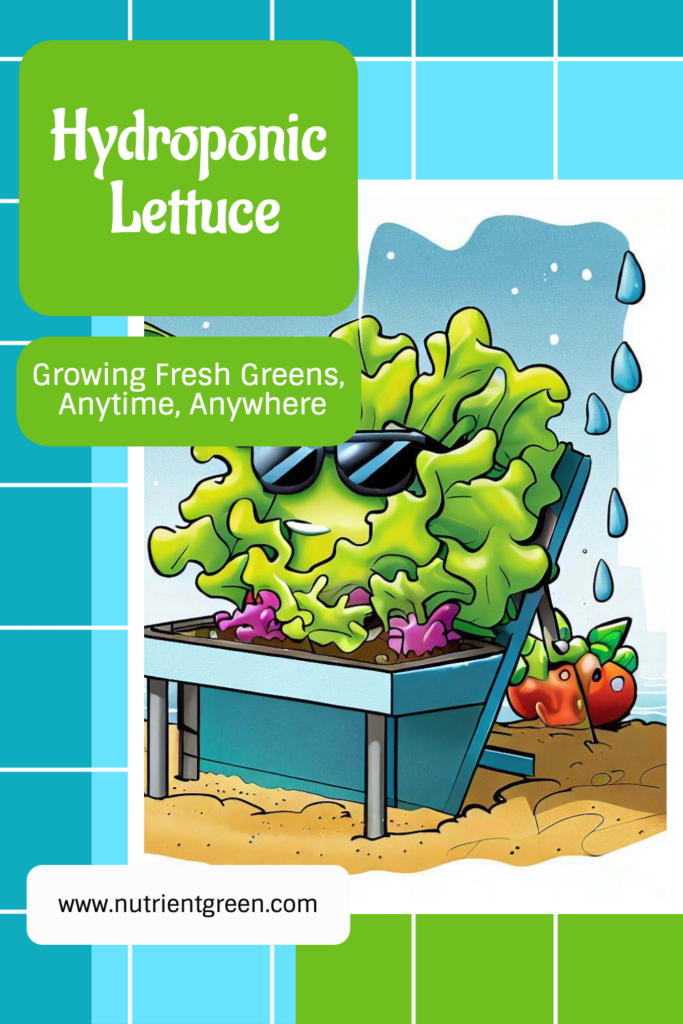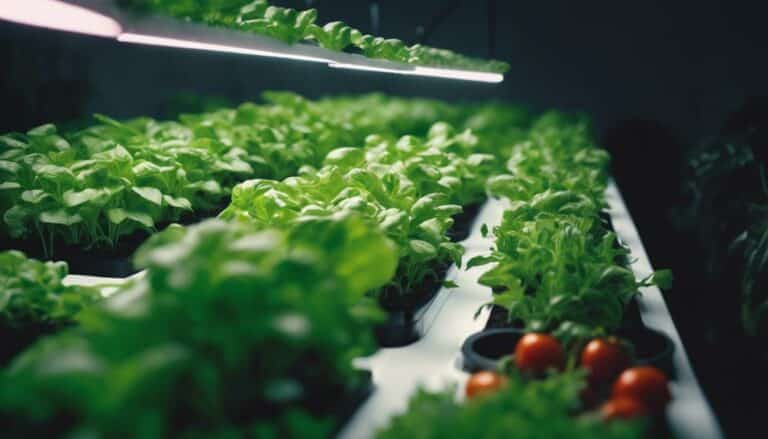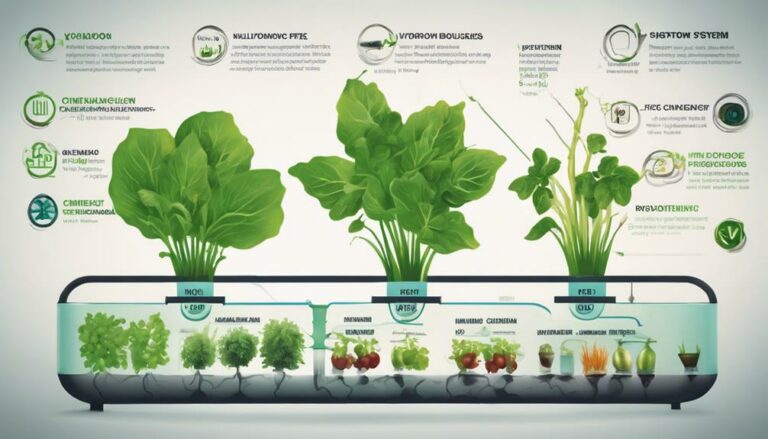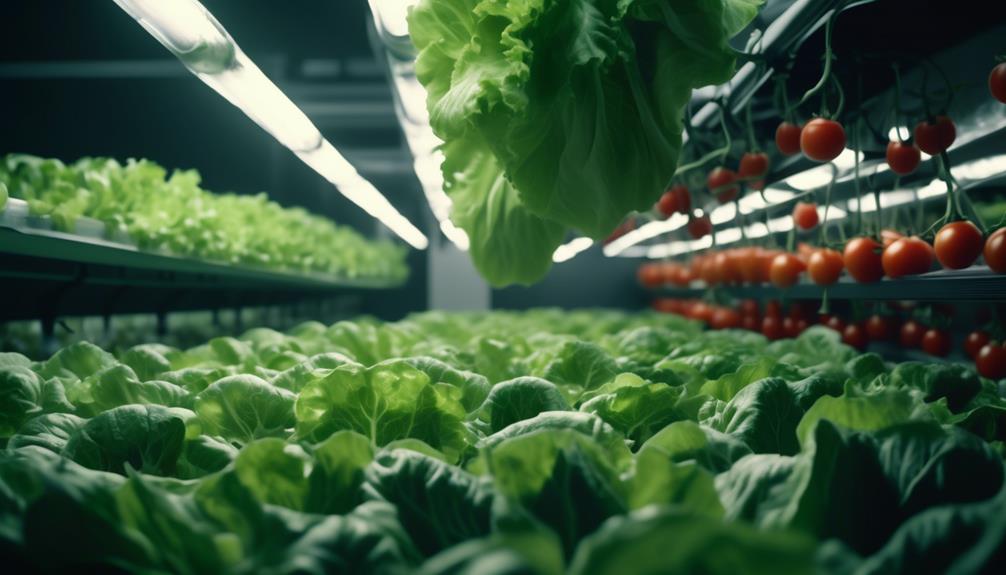In the realm of agricultural innovation, hydroponic lettuce cultivation stands as a testament to human ingenuity.
This ultimate guide is crafted for those who yearn to pioneer the frontiers of soil-less farming, offering a treasure trove of seasoned tips for optimizing your hydroponic system.
Yes, you can grow hydroponic lettuce. It is a soil-less method of cultivating lettuce using a nutrient-rich water solution, offering advantages such as rapid growth and efficient use of water and nutrients. It is an ideal choice for both novice and seasoned growers.
Table of Contents
In this article, we will explain what hydroponic lettuce is, why you should grow it, what types of systems you can use, and how to grow it step by step. By the end of this guide, you will be ready to start your own hydroponic lettuce garden and enjoy fresh salads all year round.
Immerse yourself in the nuances of nurturing leafy greens amidst water, ensuring a bountiful harvest through precision and care.
Embrace this journey to elevate your greens to unparalleled vitality.
Key Takeaways
- Choose a hydroponic system that suits your space, budget, and expertise.
- Select a suitable growing medium such as rockwool cubes, perlite, or coconut coir.
- Use a nutrient solution specifically formulated for hydroponic lettuce.
- Monitor and adjust the pH and nutrient levels using a pH and EC meter.
Exploring Lettuce Hydroponically: A Comprehensive Guide
Hydroponic cultivation stands at the forefront of agricultural innovation, offering an environmentally sound method to grow crops like lettuce with remarkable efficiency. Opting for lettuce in hydroponic systems capitalizes on its rapid growth cycle and minimal requirements for successful cultivation, making it an ideal choice for both novice and seasoned growers.
Hydroponics is a method of growing plants without soil, using a nutrient-rich water solution instead. It has many advantages over traditional gardening, especially for lettuce, which is one of the easiest and most rewarding crops to grow hydroponically.
This comprehensive guide aims to equip enthusiasts with the essential knowledge to nurture lush, nutritious lettuce, leveraging hydroponic technology for peak freshness and yield.
What is Hydroponic Cultivation
Cultivation without the use of soil, known as hydroponics, offers an innovative approach to growing lettuce by utilizing a nutrient-rich water solution. This method of hydroponic cultivation represents a paradigm shift in agriculture, challenging traditional farming by growing plants without soil. The controlled hydroponic environment provides plants with an optimized balance of nutrients and water, directly to their roots, via a carefully managed nutrient solution.
- Hydroponic Systems: Choose from various configurations such as NFT, DWC, or aeroponics to suit your lettuce crop needs.
- Nutrient Balance: Precision in the composition of the nutrient solution ensures robust growth and flavorful yield.
- Innovative Solutions: Embrace cutting-edge technology for monitoring and automating your hydroponic system, maximizing efficiency and productivity.
Embarking on hydroponic cultivation is not just gardening; it’s an adventure in agricultural innovation.
Why Choose Lettuce for Hydroponics
Selecting lettuce for hydroponic cultivation offers numerous advantages, including rapid growth rates, year-round production, and efficient water and nutrient use. Lettuce hydroponically grown epitomizes the pinnacle of precision agriculture, marrying innovation with sustainability.
Enthusiasts of hydroponic lettuce cultivation are often astounded by the sheer variety of lettuce varieties that flourish in these soilless systems. Each variety, from crisp romaine to delicate butterhead, finds a niche within the hydroponic realm, benefiting from optimal nutrient delivery and controlled environmental conditions.
The benefits of hydroponic lettuce are manifold; not only does this method conserve precious resources, it also provides clean, uncontaminated produce. Lettuce is ideal for hydroponics due to its adaptable nature and compatibility with various hydroponic techniques, proving that the future of agriculture can indeed be leafy green and water-wise.
Why Lettuce is Best for Hydroponics: An In-Depth Look
Lettuce stands out as an exemplar crop for hydroponic cultivation due to its rapid growth cycle and minimal root structure, which allows for dense planting and efficient water usage.
The environmental benefits of hydroponic lettuce are profound; it significantly conserves water and can be grown in controlled environments year-round, reducing the carbon footprint associated with traditional farming.
Moreover, hydroponically grown lettuce often boasts higher nutritional value, with crisp, vibrant leaves that are untainted by soil-borne diseases, making it a superior choice for health-conscious consumers and sustainable agriculture advocates alike.
Nutritional Benefits of Hydroponic Lettuce
While hydroponic systems offer a controlled environment for plant growth, they particularly enhance the nutritional quality of lettuce by ensuring consistent access to tailored nutrients and water. This precise delivery system ensures that hydroponic lettuce absorbs an optimal balance of minerals and vitamins, making it a powerhouse of nutrition.
- Maximized Nutrient Uptake: Hydroponic nutrients and water are delivered directly to the roots, increasing efficiency and resulting in nutrient-dense leaves.
- Purity and Safety: Grown in sterile conditions, hydroponic lettuce is less likely to contain contaminants, supporting a clean eating lifestyle.
- Sustainability: Hydroponic systems use nutrient-rich water more efficiently, preserving resources and providing a continual yield of fresh vegetables such as lettuce.
This innovative cultivation method is transforming how we approach hydroponic crops, providing accessible, healthful food options.
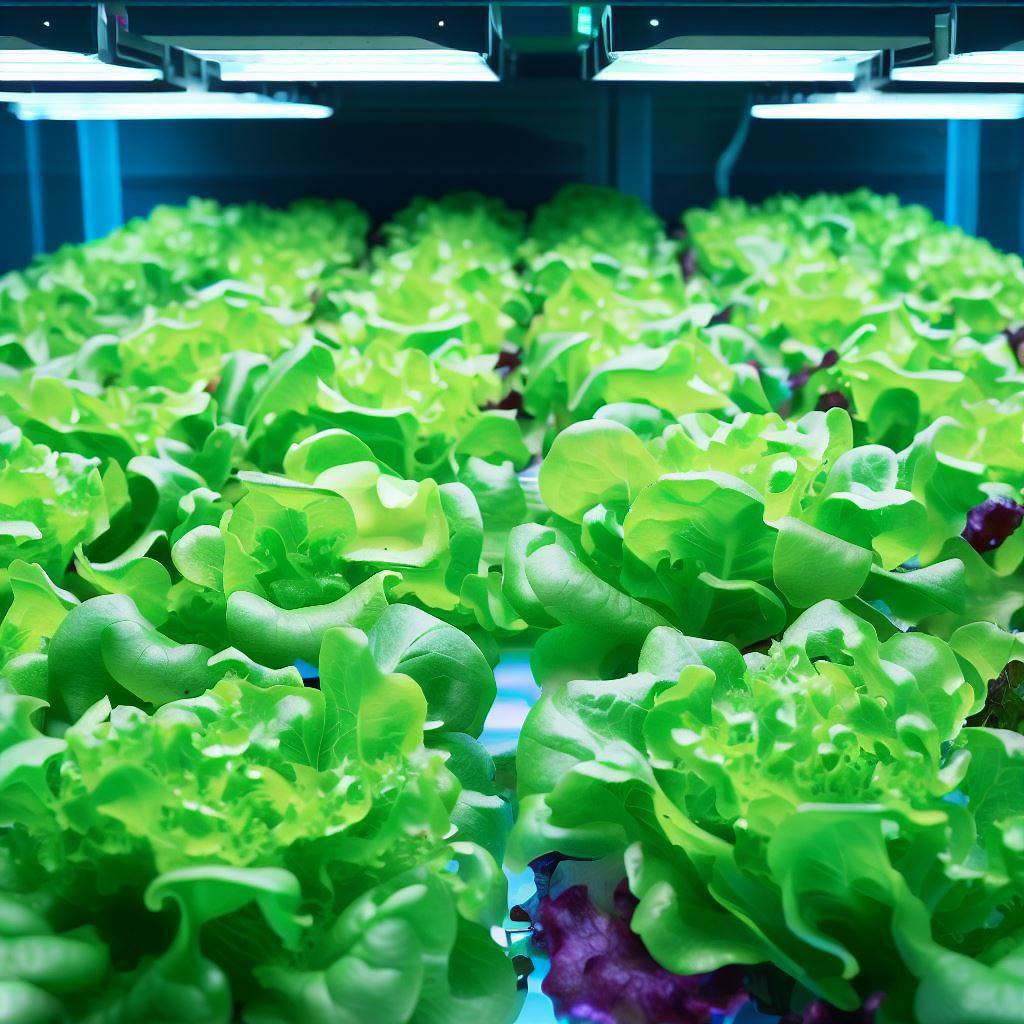
Environmental Advantages
Building on the nutritional benefits previously outlined, hydroponic lettuce offers significant environmental advantages due to its efficient use of water and space.
In a hydroponic garden, water culture systems recirculate precious H2O, dramatically reducing consumption compared to traditional soil farming. This is not only a boon for water conservation but also for those who wish to cultivate in arid regions or urban settings where space and resources are at a premium.
The use of inert growing media and a carefully managed nutrient reservoir for your lettuce ensures that plants receive optimal nourishment with minimal waste. These environmental advantages underscore the sustainable ethos of hydroponics, making it an exemplary method for growing greens while stewarding our planet’s resources.
Why Lettuce is the Best Choice for Hydroponics
Embracing hydroponic systems for cultivating lettuce offers unparalleled advantages, including faster growth rates, year-round production, and efficient water usage, making it a top choice for both commercial growers and hobbyists. The best hydroponic setups optimize these benefits, creating an ideal environment where lettuce thrives. As we delve deeper, we uncover why lettuce is the easiest vegetable to grow hydroponically and how hydroponic lettuce needs are met with precision and care.
The reasons why lettuce is perfectly suited for hydroponic cultivation are clear:
- Rapid Growth Cycles: Lettuce in hydroponics matures significantly faster compared to soil-grown counterparts, providing a quicker turnaround from seed to harvest.
- Minimal Nutrient Requirements: Hydroponic lettuce needs are straightforward, requiring a simple nutrient solution without the complexities of soil fertility management.
- Disease Resistance: Hydroponic systems for lettuce minimize the risk of soil-borne diseases, resulting in healthier plants and cleaner produce.
With a focus on innovation, these systems are continuously refined, ensuring that hydroponic lettuce remains at the forefront of sustainable agriculture. The fusion of passion and expertise in hydroponics propels lettuce to be the epitome of efficient and eco-friendly cultivation.
Essentials of Hydroponic Growing: Focus on Lettuce
Cultivating hydroponic lettuce requires a harmonious blend of essential components and diligent management of water and nutrients.
Selecting the appropriate hydroponic system and growing medium is foundational to lettuce success, ensuring roots are adequately supported and oxygenated for optimal growth.
Mastery of nutrient balance and water quality, monitored by reliable meters, is paramount to producing crisp, nutritious lettuce with a robust flavor profile.
Key Components of a Hydroponic System
In a successful hydroponic system designed for growing lettuce, several key components are essential. These include a reservoir, a suitable growing medium, a reliable water pump, accurate pH and EC meters, and an appropriate lighting system. These elements work in tandem to create an optimal environment for hydroponic plants to thrive.
The chosen growing medium must effectively support root systems while facilitating nutrient uptake. Options for growing mediums include rockwool, clay pellets, or perlite.
The reservoir is a crucial component as it houses the nutrient solution that is critical for plant sustenance.
A water pump and nutrient film are necessary to ensure the continuous flow and distribution of the nutrient-rich solution.
An inspired hydroponic setup intertwines these components, showcasing the fusion of nature and technology, and propelling growing systems into the future of agriculture.
Managing Water and Nutrients
Efficient management of water and nutrients is paramount in a hydroponic system to ensure the robust growth and optimal yield of lettuce crops.
Selecting the appropriate hydroponic system is the cornerstone for facilitating the precise delivery of a balanced hydroponic solution to the eager plant roots.
With a passion for plant vitality, every detail matters—from the pH to the electrical conductivity of the water and nutrient mix.
This meticulous approach to lettuce growth champions innovation, harnessing the prowess of modern techniques to foster unparalleled harvests.
The commitment to excellence is exemplified in the artful orchestration of nutrients, ensuring each lettuce head flourishes, embodying the pinnacle of hydroponic perfection.

Essential Tips to Grow Hydroponically: Focusing on Lettuce
Achieving optimal growth in hydroponic lettuce necessitates meticulous control over light and temperature, which are pivotal variables in the plant’s developmental symphony.
Vigilance in managing pests and diseases is equally crucial, as these can swiftly compromise the health and yield of your crop in a controlled hydroponic environment.
As we explore these essential tips, remember that precision and proactive measures are the cornerstones of thriving hydroponic lettuce cultivation.
Light and Temperature Control
For optimal growth of hydroponic lettuce, precise control over light exposure and ambient temperature is crucial. Enthusiasts and commercial growers alike must understand that lettuce thrives under specific conditions that can be effectively managed in an indoor hydroponic environment. Leveraging advanced grow light technology ensures that lettuce receives the ideal spectrum and intensity of light per day it needs to flourish.
- Grow Light Selection: Invest in high-quality LED grow lights that mimic the full spectrum of sunlight.
- Daily Light Cycle: Provide lettuce with 12-14 hours of light per day, simulating natural daylight patterns.
- Temperature Regulation: Maintain an ambient temperature of 65-75°F (18-24°C) during the day, slightly cooler at night.
Embrace these tips with fervor, and you’ll cultivate lush, vibrant hydroponic lettuce, rich in both flavor and nutrition.
Pests and Disease Management
While precise control over light and temperature is imperative for healthy hydroponic lettuce growth, diligent management of pests and diseases is equally crucial to ensure the longevity and quality of your crop.
Grow hydroponic lettuce with the foresight that a robust hydroponic system does more than nurture—it safeguards. Vigilant pests and disease management begins with preventative measures: implementing yellow sticky traps to monitor insect activity, introducing beneficial insects to counteract pests, and ensuring proper air circulation to deter fungal growth.
Sterilize your tools and maintain cleanliness to prevent pathogen spread. Treat your lettuce plants like the living investments they are, and they’ll reward you with bountiful, vibrant yields.
With these methodologies, growing hydroponic becomes a resilient art—an interplay between innovation and nature’s nuances.
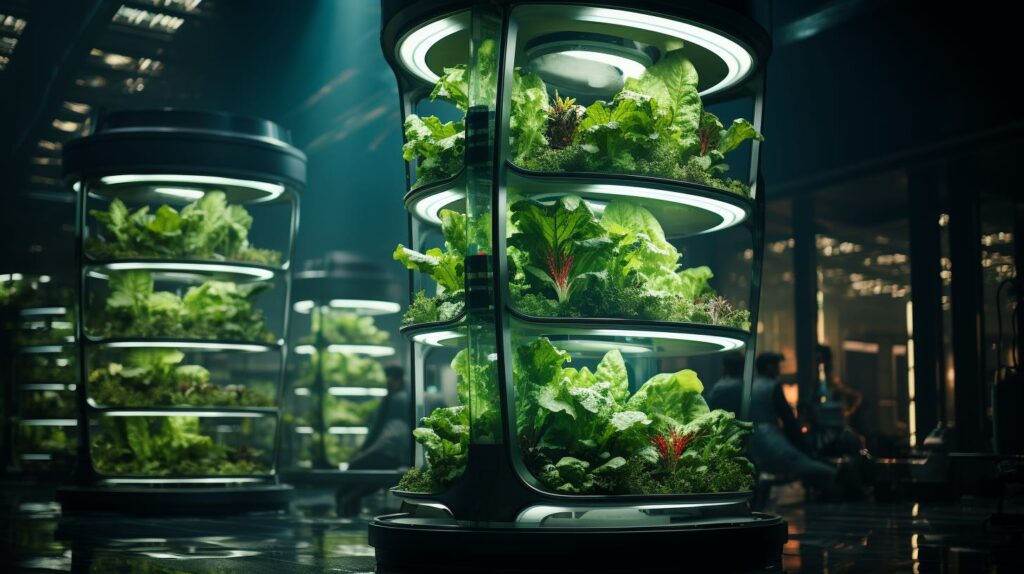
Indoor Hydroponic Techniques for Thriving Lettuce Plants
To ensure your indoor hydroponic lettuce plants flourish, it’s crucial to implement specific techniques tailored to their unique growing environment. Optimizing your hydroponic system not only paves the way for robust growth but also ensures that your lettuce varieties will regrow efficiently. The key to success lies in the precision and innovation with which you approach hydroponic growing.
As a seasoned cultivator, I’ve identified three pivotal elements that are the cornerstone of thriving indoor hydroponic gardens:
- Optimal Lighting: LED grow lights meticulously calibrated to emit the perfect spectrum encourage photosynthesis and healthy growth. Ensure your lettuce receives ample light without overheating.
- Nutrient Management: A balanced, pH-adjusted nutrient solution is the lifeblood of hydroponically grown lettuce. Regularly monitor and adjust nutrient concentrations to cater to the specific needs of different lettuce varieties.
- Environmental Control: Precise regulation of temperature and humidity within the growing area is vital. Lettuce thrives in a consistent and controlled environment, free from fluctuations that can stress the plants.
Hydroponic Setup: A Step-by-Step Guide for Lettuce Cultivation
Several factors must be carefully considered when setting up a hydroponic system for cultivating lettuce to ensure optimal growth and yield. An impeccable hydroponic setup begins with the selection of robust lettuce seeds, specifically chosen for their compatibility with hydroponic cultivation. These tiny powerhouses promise a lush bed of greenery when nurtured in a meticulously engineered environment.
Enthusiasts must then transition their focus to the nurture of delicate lettuce seedlings, which serve as the foundation for a thriving hydroponic garden. It is within the cradle of advanced drip systems, where these seedlings find their vigor, slowly unfurling into verdant leaves under the watchful eye of the grower.
The magic of hydroponics lies in the symphony of nutrient delivery, light, and care. Every drop of the nutrient solution is a lifeline to the burgeoning lettuce, while the controlled drip systems ensure a steady flow of sustenance. This is horticultural artistry, a blend of science and passion that culminates in the crisp, fresh lettuce leaves that are the joy and pride of any hydroponic gardener.
With precision, care, and a relentless pursuit of innovation, hydroponic lettuce cultivation is an endeavor that rewards both the palate and the spirit.
Setting Up Your Hydroponic System for Optimal Lettuce Growth
Erecting a sanctuary for your hydroponic lettuce requires meticulous attention to location and equipment—a decisive step in fostering a thriving crop.
Selecting a site that balances ambient light with controllable environmental factors, such as temperature and humidity, is pivotal to your greens’ vigor.
Equipping yourself with a comprehensive checklist, including a suitable hydroponic system, reliable nutrient solutions, and precise monitoring tools, guarantees that you are poised for success in your horticultural venture.
Choosing the Right Location
Selecting an appropriate location for your hydroponic system is crucial to ensure optimal growth conditions for hydroponic lettuce. As a seasoned cultivator, I’ve learned that the right environment can significantly elevate the quality and yield of your indoor hydroponic lettuce.
When you set up your hydroponic system, consider these pivotal factors:
- Lighting: Guarantee a minimum of 14-16 hours of light daily for vigorous growth.
- Temperature: Maintain a stable environment, ideally between 68°F to 72°F, to promote healthy lettuce.
- Air Circulation: Ensure good airflow to prevent disease and support plant respiration.
Harnessing the potential to grow lettuce indoors requires meticulous attention to these details, crafting an ambient haven for your leafy greens to thrive.
Equipment Checklist
To ensure optimal lettuce growth, your hydroponic system should include the following essential equipment: a reliable water pump, grow lights tailored for leafy greens, pH and EC meters, and appropriate growing medium and nutrient solutions.
Passionately crafted for the modern grower, this equipment checklist encapsulates the innovation required for thriving lettuce yields. By selecting specific hydroponic components, you’re not just growing lettuce using cutting-edge methods; you are part of a revolution in sustainable agriculture.
| Equipment | Purpose | Recommended for Lettuce |
|---|---|---|
| Reliable Water Pump | Circulate nutrient solution | Essential for all systems |
| Grow Lights | Provide adequate light spectrum | Tailored for leafy greens |
| pH and EC Meters | Monitor nutrient and pH levels | Crucial for plant health |
| Growing Medium & Nutrients | Support and feed plants | Matched to lettuce needs |
Invest in quality hydroponic seeds and watch as your green haven flourishes under your expert care.
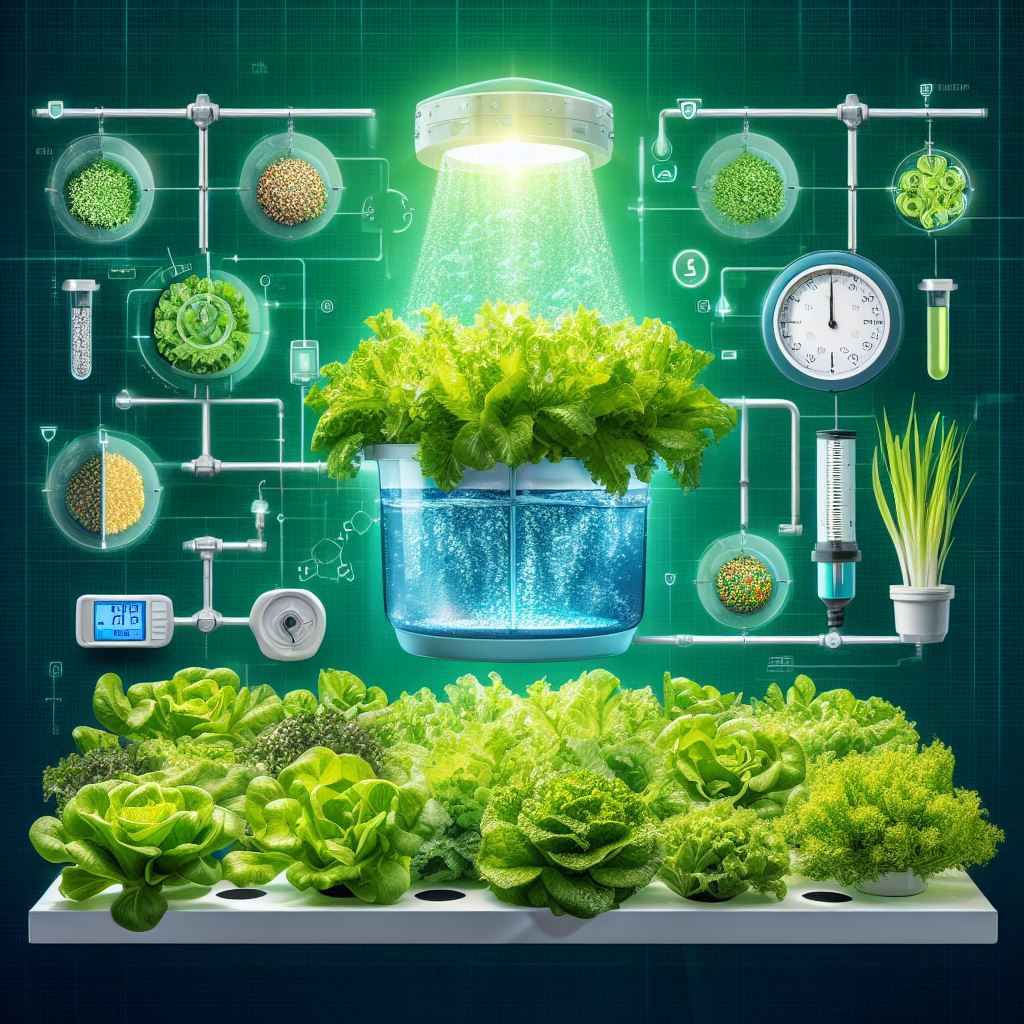
Choosing the Best Hydroponic Systems for Lettuce Cultivation
When determining the optimal hydroponic system for lettuce cultivation, it is essential to assess factors such as available space, budget constraints, and level of expertise. For enthusiasts eager to plunge into the world of hydroponic lettuce cultivation, selecting the right system is pivotal to success. Lettuce, with its variety of types, thrives in systems tailored to its specific needs. Understanding the nuances of each system ensures that the best lettuce for hydroponics is grown in an environment conducive to robust growth and bountiful harvests.
The following are key considerations for choosing a hydroponic system:
- System Efficiency: Opt for a setup that maximizes space and resource use.
- Lettuce Variety: Select a system compatible with the types of lettuce you wish to grow.
- Ease of Management: Choose a system that aligns with your skill level and time commitment.
In the realm of hydroponic systems for lettuce, options abound. Deep Water Culture (DWC) is lauded for its simplicity and effectiveness, particularly for beginners. Nutrient Film Technique (NFT) and Ebb & Flow systems cater to more experienced growers, offering precision and higher yields. Ultimately, the goal is to foster an environment where lettuce in a hydroponic system can flourish, leading to successful hydroponic lettuce cultivation.
Choosing the Ideal Lettuce to Grow Hydroponically: Expert Recommendations
Selecting the appropriate variety is pivotal in hydroponic lettuce cultivation, where each species’ unique requirements and attributes come into play.
Expert growers often recommend varieties such as Romaine for its robustness and Butterhead for its tender leaves, both of which have proven to thrive in a soilless environment.
It is essential to consider the growth patterns, nutritional needs, and harvest cycles of these varieties to optimize yield and quality in your hydroponic setup.
Varieties Suited for Hydroponic Cultivation
Lettuce varieties such as Butterhead, Oak Leaf, and Romaine are particularly well-suited for hydroponic cultivation, offering a range of textures and flavors for growers and consumers alike. These leafy greens thrive in controlled environments, allowing for year-round production and an efficient use of resources.
When choosing lettuce varieties for your hydroponic system, consider these expert recommendations:
- Butterhead Lettuce: Offers a delicate texture and sweet flavor, making it the best lettuce for hydroponics enthusiasts seeking gourmet quality.
- Oak Leaf Lettuce: Its unique leaf shape and vibrant colors add visual appeal, perfect for those looking to grow lettuce hydroponically with an artistic touch.
- Romaine Lettuce: Known for its crispness and durability, ideal for hydroponic lettuce outdoors due to its robust nature.
Selecting the right varieties can ensure success and satisfaction in your hydroponic endeavors.
Identifying the Ideal Type of Lettuce for Your Hydroponic Garden
Determine the best variety of hydroponic lettuce for your garden by considering factors such as flavor preferences, growth rate, and space requirements. The type of lettuce you select will influence the overall productivity and satisfaction with your hydroponic crops. Advanced hydroponic growers know that each lettuce variety brings its own unique set of characteristics and requirements to the system.
Passionately crafted hydroponic systems deserve lettuce varieties that not only thrive in their environment but also excite the palate. Below is a table showcasing a selection of lettuce for hydroponic growers, designed to aid in making an informed choice:
| Lettuce Type | Growth Rate | Space Required |
|---|---|---|
| Butterhead | Fast | Moderate |
| Romaine | Moderate | High |
| Loose-leaf | Fast | Low |
| Crisphead | Slow | High |
| Oakleaf | Fast | Low |
Each type of lettuce brings a distinct texture and taste, ensuring a delightful harvest from your hydroponic system. Whether you’re experimenting with new lettuce varieties or optimizing your current hydroponic setup, your commitment to innovation and quality will be the key to unparalleled freshness and flavor in your hydroponic garden.
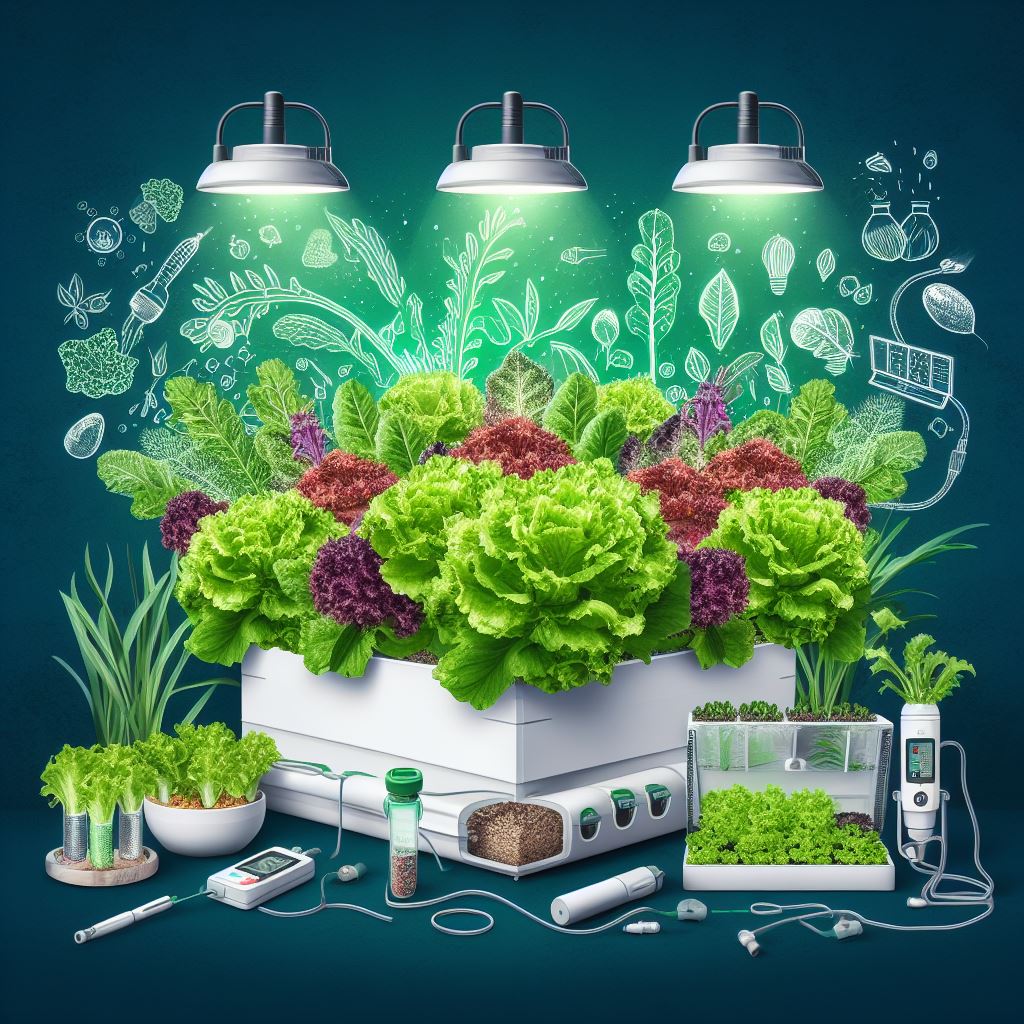
Discovering the Best Varieties of Lettuce for Hydroponic Cultivation
Explore the range of lettuce varieties suited for hydroponic cultivation to maximize yield and flavor in your garden. Investing in the best varieties of lettuce for hydroponic cultivation not only ensures a bountiful harvest but also contributes to a more sustainable and innovative approach to gardening.
When choosing lettuce to grow hydroponically, consider these top options for hydroponic systems:
- Butterhead Lettuce: Renowned for its tender leaves and sweet flavor, it’s a hydroponic favorite that thrives in controlled environments.
- Romaine Lettuce: A classic choice with crisp texture; hydroponic romaine is known for its nutrient density and robust growth.
- Leaf Lettuce Varieties: Including Red and Green Leaf lettuces, these varieties are celebrated for their rapid growth cycle and the ability to harvest leaves individually.
These lettuce varieties will regrow three or more times, offering multiple harvests from a single planting. Hydroponic lettuce may also benefit from being less susceptible to soil-borne diseases, making it a cleaner, more appealing option.
Selecting Lettuce for Hydroponic Growers: Best Practices and Varieties
Selecting the appropriate variety of lettuce is a crucial initial step for hydroponic gardeners aiming to achieve optimal growth and yield. It’s not merely about choosing a type that appeals to your palate; it’s about selecting varieties that thrive in the unique environment of a hydroponic system. When growing lettuce indoors, the conditions are meticulously controlled, which can significantly benefit certain lettuce varieties.
For those passionate about cultivating hydroponic lettuce, it is essential to observe best practices starting from the selection stage. This includes ensuring the lettuce varieties chosen are compatible with the specific hydroponic setup and can flourish under artificial light conditions. Here’s a detailed breakdown of some top-performing lettuce varieties for hydroponic growers:
| Lettuce Variety | Characteristics |
|---|---|
| Butterhead | Tender leaves, sweet flavor, fast-growing |
| Romaine | Crisp texture, nutrient-rich, heat-resistant |
| Loose-leaf | Easy harvesting, continuous yield, variety of colors |
Each variety brings its own set of benefits to the table—be it the velvety texture of Butterhead, the robustness of Romaine in different temperatures, or the ease and versatility of Loose-leaf. By choosing wisely, you set the stage for a lush, vibrant indoor garden that’s both a culinary delight and a visual feast.
Mastering the Art of Growing Lettuce Hydroponically
Mastering the art of growing lettuce hydroponically requires a precise understanding of the plant’s needs and careful management of the growing environment. Lettuce is best for hydroponics due to its rapid growth and adaptability, flourishing in a well-tuned system where soil is replaced by nutrient-rich water. This method for growing plants without traditional soil not only conserves space and resources but also accelerates growth, allowing for year-round cultivation and harvest.
To excel in hydroponic cultivation, consider the following essentials:
- System Selection: Choose a common hydroponic system like deep water culture or nutrient film technique that’s scalable and fits your goals.
- Nutrient Management: Tailor your nutrient solution with precision, maintaining optimal pH and EC levels for lettuce.
- Environmental Control: Ensure consistent temperatures, adequate lighting, and humidity to foster robust growth.
With a passion for sustainable agriculture and an eye for detail, hydroponic growers can achieve remarkable success. Embrace innovation and advanced techniques to optimize your hydroponic system, and watch as your lettuce thrives in an environment that epitomizes modern gardening excellence.
Cultivating Hydroponic Lettuce Outdoors: Innovative Approaches
Cultivating hydroponic lettuce outdoors offers a symphony of challenges and rewards, calling for a well-orchestrated adaptation to the whims of nature’s elements. By harnessing the sun’s full spectrum and the natural cycles of day and night, growers can elevate the vigor and taste of their leafy crops while simultaneously reducing energy costs.
Innovative approaches, such as integrating climate-responsive systems, ensure that outdoor hydroponic ventures thrive, marrying technology with the unrestrained beauty of the outdoors.
Adapting to Outdoor Conditions
While hydroponic lettuce is commonly grown indoors, adapting your system for outdoor conditions can expand your growing potential and introduce natural elements beneficial to plant growth. Enthusiasts seeking to grow hydroponically will be inspired by the resilience and vigor that homegrown hydroponic lettuce exhibits when exposed to the natural rhythms of the sun and air. By harnessing innovative strategies, your greens can thrive in hydroponic systems that seamlessly blend with the great outdoors.
- Optimized Natural Lighting: Utilize the sun’s cycles to enhance photosynthesis without artificial lights.
- Climate Adaptation Strategies: Implement covers or shades to protect against harsh weather while maintaining airflow.
- Integrated Pest Management: Attract beneficial insects and use non-toxic barriers to keep pests at bay.
Embrace these methods to ensure your greens are not just grown in a hydroponic system—they’re flourishing in harmony with nature.
Harnessing Natural Elements
Adapting to the natural environment, hydroponic lettuce growers can implement innovative outdoor systems that capitalize on the benefits of sunlight, rainwater, and air circulation for robust plant development.
By integrating these elements, you can grow your hydroponic lettuce with efficiency and sustainability at the forefront. Utilize the full spectrum of natural light to enhance the photosynthesis process, increasing the growth rate of varieties like crisp romaine lettuce, tender butterhead lettuce, and delicate bibb lettuce.
Ingenious collection systems can harness rainwater, reducing reliance on external water sources and creating a closed-loop hydroponic system that respects Earth’s resources.
Enhanced air circulation prevents the stagnation that plagues indoor environments, encouraging stronger, healthier plants.
Embrace these strategies to maximize yield and flavor in your outdoor hydroponic lettuce garden.
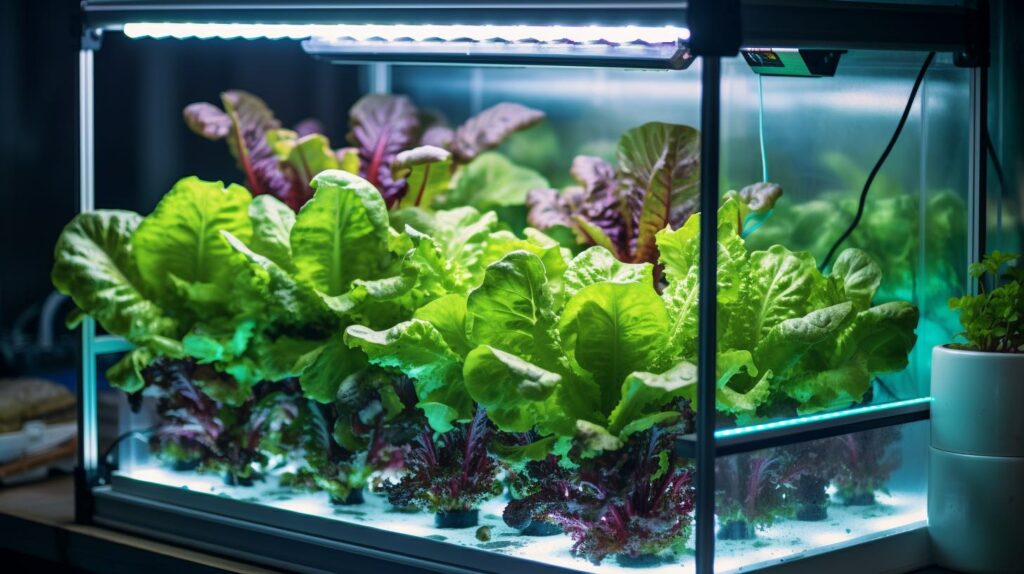
Exploring the Benefits of Hydroponic Lettuce for Home and Commercial Gardens
The cultivation of hydroponic lettuce offers significant advantages for both home gardeners and commercial growers. These advantages include efficient water use, year-round production, and a reduction in pest management challenges. By choosing to grow your lettuce hydroponically, you tap into a method that yields a popular hydroponic crop with unparalleled freshness and nutritional value. Lettuce indoors thrives, sheltered from the unpredictability of outdoor conditions, making it a consistent, reliable vegetable to grow.
The benefits of integrating hydroponic systems for lettuce cultivation are manifold. Firstly, hydroponic lettuce requires significantly less space than traditional soil-based agriculture. This allows for high-density planting and maximization of limited areas. Additionally, the controlled environment of hydroponics accelerates growth, leading to quicker harvest times and the ability to produce more crops per year. Furthermore, hydroponics conserves water and reduces the need for harmful pesticides and herbicides, contributing to a more sustainable form of agriculture.
With a detail-oriented approach, passionate hydroponic gardeners and innovative commercial producers alike can utilize advanced hydroponic techniques to cultivate robust, flavorful, and nutritious hydroponic lettuce. This is not only an agricultural revolution; it’s a lifestyle transformation for those dedicated to modern, efficient, and eco-friendly farming practices.
Benefits of Growing Hydroponic Lettuce
Growing lettuce hydroponically has many benefits compared to growing it in soil.
Here are some of them:
- Faster growth and higher yield
Lettuce is a fast-growing crop that can be harvested in as little as four weeks from seed. When grown hydroponically, it can grow even faster and produce more leaves, since it has direct access to the nutrients it needs and does not have to compete with weeds or other plants. You can also grow more plants in a smaller space, since you don’t need large pots or rows. This means you can have a continuous supply of fresh lettuce for your salads.
- Less water and nutrient consumption
Hydroponics is a water-efficient method of gardening, since the water is recirculated and reused in the system. You only need to add water when it evaporates or when you change the nutrient solution. This can save up to 90% of water compared to soil gardening. You also need less nutrients, since they are delivered directly to the plant roots and not wasted in the soil. This can save you money and reduce environmental impact.
- Better taste and nutrition
Lettuce grown hydroponically tends to taste better than lettuce grown in soil, because it is cleaner and fresher. You don’t have to worry about soil-borne contaminants, pesticides, or fertilizers affecting the flavor or quality of your lettuce. You also don’t have to wash it before eating it, since there is no dirt or dust on it. Hydroponically grown lettuce also has higher levels of vitamins, minerals, antioxidants, and phytochemicals than soil-grown lettuce, because it can absorb more nutrients from the water solution.
- No soil-borne pests and diseases
One of the biggest challenges of growing lettuce in soil is dealing with pests and diseases that can damage or destroy your crop. Aphids, slugs, snails, caterpillars, leaf miners, fungal infections, bacterial wilt, root rot…the list goes on. When you grow lettuce hydroponically, you eliminate most of these problems, since there is no soil for them to live or breed in. You only have to watch out for some airborne pests or diseases that can still affect your plants, but they are much easier to control.
Types of Hydroponic Lettuce Systems
There are many types of hydroponic systems that you can use to grow lettuce, but we will focus on three of the most common and simple ones. For more information refer to the research paper from IOP Conference Series: The effect of hydroponics systems on the growth of lettuce – Materials Science and Engineering that compares the effect of different hydroponic systems on the growth and yield of lettuce
Water Culture System
A water culture system is one of the simplest and cheapest hydroponic systems to set up. It consists of a reservoir filled with nutrient solution, a platform that holds the plants above the water, and an air pump that oxygenates the water. The plant roots are suspended in the water and absorb the nutrients they need.
This system is ideal for growing leafy greens like lettuce, since they don’t need a lot of support or space. However, it is not suitable for larger or heavier plants that need more stability or root zone.
To build a water culture system for lettuce, you will need:
- A reservoir (a plastic container or bucket)
- A platform (a piece of styrofoam or plastic)
- Net pots (small pots with holes)
- Growing medium (rockwool cubes or perlite)
- Air pump
- Air stone
- Tubing
- Nutrient solution
- pH meter
- pH adjuster
- Lettuce seeds or seedlings
The steps are:
- Cut holes in the platform that fit the net pots.
- Fill the reservoir with water and add the nutrient solution according to the instructions on the label.
- Adjust the pH of the solution to around 6.0 using a pH meter and a pH adjuster.
- Place the air stone in the reservoir and connect it to the air pump with tubing.
- Place the platform on top of the reservoir.
- Fill the net pots with growing medium and place them in the holes on the platform.
- Plant one lettuce seed or seedling per net pot.
- Turn on the air pump and make sure there are bubbles coming out of the air stone.
- Check the water level regularly and add more water or nutrient solution as needed.
- Check the pH regularly and adjust it as needed.
Nutrient Film Technique (NFT) System for Growing Lettuce
A Nutrient Film Technique (NFT) system is another popular hydroponic system for growing lettuce. It consists of:
- A reservoir filled with nutrient solution
- A pump that circulates the solution through tubing
- Channels that hold the plants above the tubing
The plant roots are exposed to a thin film of nutrient solution that flows through the tubing and channels.
This system is ideal for growing leafy greens like lettuce, as they don’t need much support or space. However, it requires more materials and maintenance compared to a water culture system. Additionally, NFT systems are more vulnerable to power outages or pump failures that can dry out the roots.
To build an NFT system for lettuce, you will need:
- A reservoir (a plastic container or bucket)
- A pump
- Tubing
- Channels (PVC pipes or gutters)
- End caps
- Net pots (small pots with holes)
- Growing medium (rockwool cubes or perlite)
- Nutrient solution
- pH meter
- pH adjuster
- Lettuce seeds or seedlings
Follow these steps:
- Cut holes in the channels that fit the net pots.
- Drill small holes in one end cap per channel for drainage.
- Attach one end cap to each channel.
- Fill the reservoir with water and add the nutrient solution according to the instructions on the label.
- Adjust the pH of the solution to around 6.0 using a pH meter and a pH adjuster.
- Place the pump in the reservoir and connect it to one end of the tubing.
- Connect the other end of the tubing to one end of the first channel.
- Connect the other end of the first channel to one end of the second channel with another piece of tubing, and so on until you reach the last channel.
- Place the channels on a slope above the reservoir so that the nutrient solution flows from one end to another by gravity.
- Fill the net pots with growing medium and place them in the holes on the channels.
- Plant one lettuce seed or seedling per net pot.
- Turn on the pump and ensure there is a thin film of nutrient solution flowing through the tubing and channels.
- Check the water level regularly and add more water or nutrient solution as needed.
- Check the pH regularly and adjust it as needed.
Ebb and Flow System
An ebb and flow system is another hydroponic system that can be used to grow lettuce. It consists of a reservoir filled with nutrient solution, a pump that alternately floods and drains the solution into a tray, and a tray that holds the plants in pots. The plant roots are periodically submerged in the nutrient solution and then exposed to air.
This system is suitable for growing a variety of plants, including lettuce, since it provides both water and oxygen to the roots. However, it requires more space and materials than a water culture or NFT system, and it can be affected by power outages or pump failures that can drown or dry out the roots.
To build an ebb and flow system for lettuce, you will need:
- A reservoir (a plastic container or bucket)
- A pump
- A timer
- Tubing
- A tray (a plastic or metal tray)
- Pots (small pots with holes)
- Growing medium (rockwool cubes or perlite)
- Nutrient solution
- pH meter
- pH adjuster
- Lettuce seeds or seedlings
The steps are:
- Fill the reservoir with water and add the nutrient solution according to the instructions on the label.
- Adjust the pH of the solution to around 6.0 using a pH meter and a pH adjuster.
- Place the pump in the reservoir and connect it to one end of the tubing.
- Connect the other end of the tubing to the tray.
- Place the tray above the reservoir, making sure there is enough space for the solution to drain back into the reservoir.
- Fill the pots with growing medium and place them on the tray.
- Plant one lettuce seed or seedling per pot.
- Set the timer to flood and drain the tray at regular intervals, depending on the size of your system and the stage of your plants. A general rule is to flood the tray for 15 minutes every 4 hours during the day and every 8 hours during the night.
- Check the water level regularly and add more water or nutrient solution as needed.
- Check the pH regularly and adjust it as needed.
How to Grow Hydroponic Lettuce Step by Step
Now that you have chosen your hydroponic system, you are ready to grow your lettuce.
Here are the steps you need to follow:
Choose the best lettuce variety for hydroponics
You can grow any kind of lettuce hydroponically, but some varieties are more suited than others. The best ones are those that have loose leaves, compact heads, fast growth, and resistance to bolting (flowering). Some examples are:
- Butterhead: This type of lettuce has soft, tender leaves that form loose heads. It has a mild flavor and a buttery texture. Some varieties are Bibb, Boston, Buttercrunch, and Tom Thumb.
- Romaine: This type of lettuce has long, crisp leaves that form upright heads. It has a slightly bitter flavor and a crunchy texture. Some varieties are Cos, Parris Island, Little Gem, and Rouge d’Hiver.
- Looseleaf: This type of lettuce has curly or flat leaves that do not form heads. It has a mild flavor and a tender texture. Some varieties are Oakleaf, Lollo Rossa, Red Sails, and Black Seeded Simpson.
You can also grow related leafy greens, such as spinach, Swiss chard, kale, and bok choy for a more flavorful and nutritious salad.
Germinate lettuce seeds in a growing medium
The first step is to germinate your lettuce seeds in a growing medium. You can use any soilless medium that is sterile, porous, and moist, such as rockwool cubes or perlite.
To germinate your seeds, follow these steps:
- Fill a tray with your growing medium and moisten it with water.
- Sprinkle up to three seeds per cube or pot and cover them lightly with more medium.
- Place the tray in a warm (around 70°F) and dark place until the seeds sprout (usually within 2 to 3 days).
- Move the tray to a bright (around 10 hours of light per day) and cool (around 60°F) place until the seedlings develop their first true leaves (usually within 1 to 2 weeks).
Transplant lettuce seedlings into the hydroponic system
The next step is to transplant your lettuce seedlings into your hydroponic system. You can do this when they are about 2 inches tall and have at least two sets of true leaves.
To transplant your seedlings, follow these steps:
- Gently remove each seedling from its cube or pot without damaging its roots.
- Place each seedling into a net pot filled with growing medium (if using a water culture or NFT system) or directly into a pot filled with growing medium (if using an ebb and flow system).
- Place each net pot or pot into its slot on the platform or channel of your hydroponic system.
- Make sure that the roots are touching or submerged in the nutrient solution (if using a water culture or NFT system) or that the solution can reach them when it floods the tray (if using an ebb and flow system).
Provide adequate light, temperature, and humidity
The next step is to provide your lettuce plants with the right environmental conditions for optimal growth. You need to consider the following factors:
- Light: Lettuce needs around 10 to 14 hours of light per day to grow well. You can use natural sunlight if you have a sunny window or a balcony, or artificial lights if you don’t. You can use fluorescent tubes, LED lights, or HID lights, depending on your budget and space. The ideal light intensity for lettuce is around 200 to 400 micromoles per square meter per second (µmol/m2/s).
- Temperature: Lettuce prefers cool temperatures between 60°F and 70°F. If the temperature is too high (above 80°F), the plants may bolt (flower prematurely) and become bitter. If the temperature is too low (below 50°F), the plants may grow slowly and become susceptible to diseases. You can use a fan, a heater, or an air conditioner to regulate the temperature in your growing area.
- Humidity: Lettuce likes high humidity levels between 60% and 80%. If the humidity is too low (below 40%), the plants may wilt and lose water. If the humidity is too high (above 90%), the plants may develop fungal infections or rot. You can use a humidifier, a dehumidifier, or a ventilation system to control the humidity in your growing area.
Feed your lettuce with the right nutrient solution
The next step is to feed your lettuce plants with the right nutrient solution for their growth stage. You need to consider the following factors:
- Nutrient concentration: The nutrient concentration is measured by the electrical conductivity (EC) of the solution. It indicates how much dissolved salts are in the water. The ideal EC for lettuce is around 1.0 to 1.5 millisiemens per centimeter (mS/cm). If the EC is too low (below 0.5 mS/cm), the plants may show signs of nutrient deficiency, such as yellowing or stunted growth. If the EC is too high (above 2.0 mS/cm), the plants may show signs of nutrient toxicity, such as browning or wilting.
- Nutrient ratio: The nutrient ratio is measured by the percentage of nitrogen (N), phosphorus (P), and potassium (K) in the solution. It indicates how much of each macronutrient is available for the plants. The ideal N-P-K ratio for lettuce is around 4-2-6. This means that for every 100 parts of total nutrients, there should be 4 parts of nitrogen, 2 parts of phosphorus, and 6 parts of potassium. You can use a premixed hydroponic fertilizer that has this ratio, or you can mix your own using individual nutrient salts.
- Nutrient pH: The nutrient pH is measured by the acidity or alkalinity of the solution. It indicates how well the plants can absorb the nutrients from the water. The ideal pH for lettuce is around 6.0. If the pH is too low (below 5.5), the plants may have difficulty absorbing some nutrients, such as calcium or magnesium. If the pH is too high (above 6.5), the plants may have difficulty absorbing some nutrients, such as iron or manganese.
You need to check and adjust these factors regularly using a digital meter, a pH adjuster, and a nutrient solution chart.
Table 1: nutrient solution chart for hydroponic lettuce
| Element | ppm in nutrient solution | % of plant dry weight |
|---|---|---|
| Nitrogen (N) | 150 | 4.5 |
| Phosphorus (P) | 16 | 0.5 |
| Potassium (K) | 132 | 5.0 |
| Calcium (Ca) | 38 | 0.5 |
| Magnesium (Mg) | 14 | 0.3 |
| Sulfur (S) | 30 | 0.3 |
| Iron (Fe) | 2.10 | 0.0015 |
| Manganese (Mn) | 0.47 | 0.0005 |
| Zinc (Zn) | 0.49 | 0.0005 |
| Boron (B) | 0.21 | 0.0003 |
| Copper (Cu) | 0.13 | 0.0002 |
| Molybdenum (Mo) | 0.08 | – |
Harvest your hydroponic lettuce and enjoy
The final step is to harvest your hydroponic lettuce and enjoy it in your salads or sandwiches. You can harvest your lettuce in different ways depending on your preference:
- Cut-and-come-again: This method involves cutting only a few leaves from each plant at a time, leaving enough for them to regrow. This way, you can have multiple harvests from each plant over several weeks.
- Whole-head: This method involves cutting off the entire head of lettuce at its base when it reaches its full size and shape. This way, you can have larger and more uniform heads of lettuce, but only one harvest per plant.
- Baby-leaf: This method involves harvesting the young and tender leaves of lettuce when they are only a few inches tall. This way, you can have a quick and continuous harvest of baby greens for your salads.
To harvest your lettuce, follow these steps:
- Use a sharp knife or scissors to cut the leaves or heads of lettuce at their base, leaving about an inch of stem attached to the roots.
- Wash the lettuce under running water to remove any dirt or debris.
- Dry the lettuce with paper towels or a salad spinner.
- Store the lettuce in a plastic bag or container in the refrigerator for up to a week.
Conclusion
Growing hydroponic lettuce is a fun and rewarding hobby that anyone can do at home. It has many benefits over soil gardening, such as faster growth, higher yield, better taste, and less pests and diseases. You can choose from different types of hydroponic systems and lettuce varieties to suit your preferences and space. You can also enjoy fresh and healthy salads all year round from your own hydroponic garden.
Here are some tips to help you grow hydroponic lettuce successfully:
- Start with good quality seeds or seedlings from a reputable source.
- Choose a hydroponic system that matches your budget, space, and skill level.
- Provide adequate light, temperature, and humidity for your lettuce plants.
- Feed your lettuce with the right nutrient solution for their growth stage.
- Check and adjust the water level, pH, and EC of your nutrient solution regularly.
- Harvest your lettuce when it reaches its desired size and shape.
- Wash and store your lettuce properly before eating it.

FAQs
How much lettuce can I grow in a hydroponic system?
The amount of lettuce you can grow in a hydroponic system depends on several factors, such as the size of your system, the type of lettuce you grow, and how often you harvest it. As a general rule, you can expect to grow about one head of lettuce per square foot of growing space per month.
How often should I change the nutrient solution in my hydroponic system?
The frequency of changing the nutrient solution in your hydroponic system depends on the type of system you use, the size of your reservoir, and the number of plants you grow. As a general rule, you should change the nutrient solution every two to four weeks to prevent nutrient depletion or accumulation.
Why is my hydroponic lettuce bitter?
Hydroponic lettuce can become bitter for several reasons, such as high temperature, low humidity, nutrient imbalance, or bolting (flowering). To prevent or reduce bitterness in your hydroponic lettuce, you should:
• Keep the temperature between 60°F and 70°F
• Keep the humidity between 60% and 80%
• Use a balanced nutrient solution with an EC of 1.0 to 1.5 mS/cm
• Harvest your lettuce before it bolts
Can I grow other plants besides lettuce in my hydroponic system?
Yes, you can grow other plants besides lettuce in your hydroponic system, as long as they have similar requirements for light, temperature, humidity, and nutrients. Some examples of plants that can grow well with lettuce are spinach, kale, Swiss chard, basil, mint, parsley, cilantro, and chives.
Can I reuse the water or growing medium from my hydroponic system?
Yes, you can reuse the water or growing medium from your hydroponic system if you take some precautions. For the water, you should filter it to remove any solids or impurities before reusing it. You should also test and adjust its pH and EC before adding new nutrients. For the growing medium, you should sterilize it to kill any pathogens or pests before reusing it. You can use bleach, hydrogen peroxide, or boiling water to sterilize your growing medium. You should also rinse it well to remove any residues.
How long does it take for hydroponic lettuce to mature?
Depending on the variety, hydroponic lettuce can reach maturity in approximately 4-8 weeks from seedling stage to harvest.
Can Hydroponic Lettuce Be Grown in Extreme Climates, and How Would You Adjust the System to Cater to Such Conditions?
Hydroponic lettuce can indeed thrive in extreme climates, given that controlled environments mitigate external temperature fluctuations. Innovative insulation, heating, cooling, and lighting solutions are key to maintaining optimal growth conditions year-round.
What Are the Potential Challenges of Scaling up a Hydroponic Lettuce Operation From a Small Home Setup to a Commercial Enterprise?
Scaling up hydroponic lettuce operations involves complex logistical planning, increased resource management, and the implementation of advanced technological systems to ensure efficiency, sustainability, and consistent product quality for commercial success.
How Can You Determine if Your Hydroponic Lettuce Has Reached Its Nutritional Peak, and Are There Testing Methods for Home Growers?
To determine the nutritional peak of hydroponic lettuce, home growers can conduct tissue analysis or utilize home testing kits that measure essential nutrient levels, ensuring innovative and optimal plant health.
What Are the Most Common Mistakes Newcomers Make When Starting With Hydroponic Lettuce, and How Can They Be Avoided?
Newcomers to hydroponic lettuce often neglect proper pH balance and nutrient ratios, leading to suboptimal growth. Avoid these pitfalls by rigorously monitoring environmental factors and adhering to precise nutrient management protocols.
Can Hydroponic Lettuce Be Integrated Into Aquaponic Systems, and What Considerations Should Be Taken Into Account for Such a Setup?
Hydroponic lettuce can indeed complement aquaponic systems, merging plant cultivation with fish farming. Carefully balance water quality, nutrient levels, and system design to ensure symbiotic health for both plants and aquatic life.
